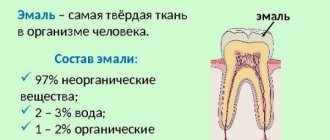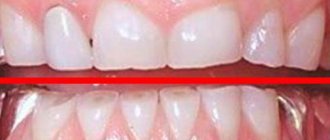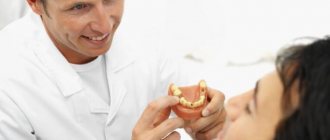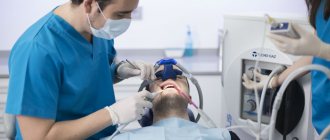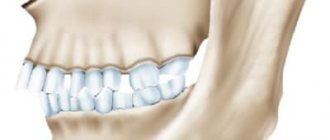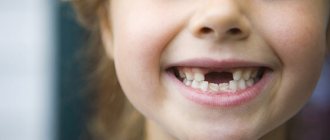4251
In modern orthodontics, several types of devices are used to correct defects in the dental system - splints, braces, mouthguards, complex devices.
For certain indications, to clarify the severity of the defect and prepare for the main therapy, doctors recommend that patients wear a Kois deprogrammer.
General overview
Finding the jaw cosmos is a complex and time-consuming process for orthodontists. However, today this difficult task has become solvable with the help of the Kois deprogrammer, which has made the process of determining the median landmark obvious and uncomplicated.
Remarkable! The centric relation is determined when the joint (condylar process of the movable jaw) is in the upper posterior position.
The practical experience of specialists has shown that complex work in the oral cavity aimed at increasing the height of occlusion is best carried out on the basis of the CS.
The process of determining the CA is described in many scientific publications on dentistry, however, the result does not always live up to expectations. Practicing orthodontists note the difficulty of registering the jaw in the CS in many clinical cases.
Dr. John Kois not only proposed considering the object as a system for assessing risks in treatment according to three main provisions, but also invented an effective apparatus for installing the central nervous system.
The Koys deprogrammer is a removable plastic product that covers the hard palate and works to create one point of contact between the frontal incisors of the movable jaw and the frontal bite pad.
The device is used for the following purposes:
- As a diagnostic tool that determines the center of gravity of the jaw at the limit of fissure-tubercle contact. This means that the device must find the optimal position of the jaw for the central nervous system - moved forward or backward.
- To control bite height.
- To seek early contact. This means that the device detects any oncoming contact during the closure of the movable jaw when the joint is in the correct position, that is, it must be in the concave articular surface.
- As a diagnostic device for identifying pathological abrasion of units.
Modern methods of closing gaps in the absence of incisors in orthodontic and prosthetic dentistry. Come here if you are interested in what cases require an orthodontic consultation.
At this address https://dr-zubov.ru/ortodontiya/prikus/kovarstvo-tortoanomalii.html we will talk about tortoanomaly in great detail.
Preparation
Before installing the device, the doctor carefully examines each patient, taking accurate measurements. The accuracy of occlusion correction depends on the individual approach to determining the central point.
The doctor assesses all the risks and only after that installs the Kois deprogrammer. Based on individual data from biochemical, periodontal, and dentofacial examinations and the study of functional parameters, he selects an individual tactic for occlusion correction using a deprogrammer.
The lowest level of risk occurs when there is a slight occlusion and acceptable functionality of the masticatory apparatus. For patients at greatest risk due to neurological disorders, doctors choose integrative treatment approaches.
Indications and contraindications
The need to determine the CV of the jaws using the Koys apparatus arises in the following cases:
- preparation before orthodontic or orthopedic treatment, involving occlusal analysis;
- absence of extreme units in the row of the upper or movable jaw;
- decreased bite;
- displacement of the movable jaw into a forced incorrect position;
- hyperextension of the ligamentous-capsular apparatus of the TMJ;
- prosthetics of the jaw row with complete edentia;
- deformed dentition, when an unfixed bite is diagnosed due to the absence of most units that come into contact with maximum intercuspal closure of the teeth;
- changes in the anatomical shape of crowns due to their wear for planning occlusal restoration;
- determining methods for restoring occlusion after grinding a large number of teeth;
- detection of eccentric supercontacts in lateral clamping positions.
Let's consider contraindications for the deprogrammer:
- pathologies of the TMJ , requiring posterior strengthening or installation of a gnathological apparatus that fixes the lower jaw in the correct position;
- periodontal involvement of the lower frontal teeth (it is recommended to combine several teeth of the movable jaw into a single system using splinting in order to secure the dentition);
- increased gag reflex in the patient (you can try to eliminate the problem by changing the size of the base, which will help eliminate extensive irritation of the soft palate).
Preparatory activities
According to Dr. Kois, a predictable approach to the treatment of occlusion is possible only with proper diagnosis.
Moreover, all studies aimed at obtaining the necessary data must be carried out on an individual basis, that is, taking into account factors influencing the outcome of treatment as a whole.
Let us consider adequate diagnostic measures in detail.
Risk assessment
The practitioner must apply a systematic risk assessment in the following areas:
- Periodontal. To assess the condition of the periodontium, visual and tactile techniques are used.
The doctor monitors the condition of the gum tissue, paying attention to its density, size, shape, color and the presence of bleeding. It is important to determine the presence and depth of pockets, as well as the degree of stability of the teeth. Hardware research methods allow one to obtain a more refined assessment of the clinical picture. - Functional .
Clinical functional analysis makes it possible to get acquainted with objective information regarding the functional state of the masticatory organ. Specialists resort to a comparative analysis of muscles using palpation in tone and in its absence, assessment of the movement of the movable jaw, determination of the condition of the temporomandibular joint, obtaining preliminary data on the presence or absence of neurological signs, clinical examination of occlusion and articulation, occlusion. - Dentofacial . An important role in planning occlusal treatment is played by the assessment of dentofacial aesthetics, which consists of symmetry, balance and harmony. The doctor must determine the position of the chewing and frontal teeth, the degree of lip mobility, and evaluate the gingival margin.
- Biomechanical . It is important to identify the presence of carious, erosive lesions and defects requiring restoration. An assessment of the condition of the fillings is mandatory.
Important parameters
Assessment of occlusal parameters is the most problematic diagnostic measure.
Due to the peculiarities of the nature of the face and the unknown nature of the algorithm for the functionality of the vertical and horizontal components in the system, specialists are not confident in the clinical factors that must be encountered in a given case.
Dr. Kois strongly recommends that practitioners determine occlusion parameters using three positions:
- Position No. 1. Position of the joint.
Due to the cartilaginous formation located between the articular surfaces and the presence of soft structures, it is difficult to register the CS. The mobile connection may be in the maximum intercuspal position or represent a habitual occlusion with dysfunction. Moreover, it can be the CS, the orthopedic position of the joint or the myocentric position. - Regulation No. 2 . This position affects the relationship of the units of the anterior oral cavity, which contributes to their lengthening, changing the occlusal vertical cavity and opening the visibility of the teeth.
- Regulation No. 3 . Guiding system in the front zone. In fact, the structures that provide the functions of chewing work and carry out the chewing process from the outside inward.
Questions for the patient
Dr. Kois states that there are 5 diagnoses that define occlusal risks, namely:
- optimal function (reduced level);
- decrease in chewing amplitude (medium level);
- occlusal dysfunction (moderate level);
- parafunctions (increased treatment risks);
- teeth grinding in combination with neurological problems (increased treatment risks).
This suggests that patients with anomalies falling into the low-risk group can resort to any restorative measures.
For patients suffering from teeth grinding or neurological disorders, a comprehensive approach is recommended for their treatment.
Important! The specialist must determine the level of risk before drawing up a treatment plan.
To correctly determine the diagnosis, it is important to obtain the patient’s answers to 5 main questions:
- Is chewing gum problematic? A positive answer indicates disturbances in the speed of jaw movement during chewing.
- Is it difficult to chew crackers? A positive response may confirm the presence of occlusal dysfunction.
- Are there any changes in dental units over the last 5 years? The specialist should ask about the wear and tear of the units, the condition of short and thin organs, the degree of fragility, and also, in order to be able to assess the changes, find out at what stage the disease is.
In the absence of serious dental problems, the protective layer of the tooth wears off by 1 mm in 100 years. The listed questions help the patient to voice all the changes in the dentofacial apparatus that he observes during his life.Also, thanks to the survey, the doctor can determine the correspondence of the condition of the teeth to the biological age of the patient. In addition, it is important to determine the activity of changes.
If the patient does not react in any way to the existing pathology, that is, he has adapted and no longer experiences discomfort, then such addiction can result in an unfavorable result.
For example, the frontal group of a person’s teeth was worn out and, despite the poor condition of the units, he installed veneers on them without correcting the occlusion. Such a restoration cannot be called successful.
- Do you need to bite two or more times? A “yes” answer confirms the presence of dysfunction.
- Are there any sleep disorders? A positive answer is a reason to suspect the presence of bruxism and neurological disorders. The dentist should ask the patient about the presence of unpleasant sensations in the lower extremities in the evening, movement disorders, and find out whether the blanket interferes with him during night sleep.
It is also necessary to examine the teeth for the degree of wear and make a list of all medications taken by the patient for neurological disorders.This will help you understand more about your medical history. The physician must remember that patients with such problems cannot be helped by restoration of occlusion. Mouthguards are used to protect teeth in such cases.
The patient may answer negatively to the first three questions if he is accustomed to the disease. However, Dr. Kois cautions specialists that such a device may not result in excellent results.
For example, if the patient’s answer to the first two questions was negative, but in a conversation it turns out that he does not eat crackers at all and prefers a special diet with soft food, then such changes in preferences can also be called an adaptation.
Thus, a thorough interview helps the doctor not only make a correct diagnosis, but also convince the patient that the occlusion has changed the quality of his life. Many people do not pay attention to changes in food preferences and the visual state of the elements of the dentition, but their answers will help the dentist correctly determine the degree of addiction.
In case of incomplete adaptation and the presence of pronounced disorders, treatment is prescribed to help eliminate forced addiction.
If positive answers were given to all the questions posed, then the optimal function can be excluded. Problems do occur, and this is a big risk and an unfavorable outcome.
Questions for the patient
Violation of occlusion is accompanied by a number of symptoms that the patient experiences when eating, chewing gum, sleeping, and talking.
In order for the doctor to be able to determine the nature of occlusal dysfunction, he must know what the patient experiences during the listed actions. This can be found out using a small test consisting of 5 questions.
Depending on how the patient answers these questions, a conclusion is made about the presence or absence of occlusion:
- Do you have problems sleeping - throwing off the blanket at night, restless legs, etc.? A positive answer suggests the presence of parafunction.
- How are things going with chewing gum? Are there any difficulties or not? If the patient answers “yes,” this may indicate a limited chewing range.
- Do you have any difficulty chewing dry foods such as cookies? A “yes” answer indicates some occlusion problems.
- Do you have to bite into your food more than once to get the right piece? An affirmative answer indicates dysfunction of the dental system.
- Have there been any negative changes in the functioning of your dental system in the last five years that you noticed? In this case, the patient needs to explain that this means such negative phenomena as increased wear and mobility of teeth, weakness of the masticatory muscles, and the formation of teeth.
An affirmative answer to at least one of these questions may indicate dysfunction of the dentofacial apparatus.
Important. The patient should be warned that answers should be given based on a normal lifestyle, without refusal, for example, from regular solid food, without taking sleeping pills, etc.
Stages of formation of permanent occlusion and causes of abnormal phenomena.
In this publication, we will consider methods for determining central occlusion.
Here https://zubovv.ru/ortodontiya/prikus/kak-opredelyaetsya-vyisota.html read how to correctly determine the height of the bite.
Manufacturing stages
The procedure for manufacturing a Koys deprogrammer for recording the central ratio is divided into several stages:
- Obtaining an alginate impression of the upper and mobile jaw.
- Making a simplified object from plaster.
- Trimming the finished model.
- Installation of impressions into a device that reproduces the movement of the movable jaw (fissure-tubercle contact). The use of a face bow and additional recording elements is not required.
- Manufacturing the vestibular arch of the device from wire material (contact of the element with the occlusal surface of the units is excluded). The arch will control retention and stabilize the entire system in the oral cavity.
- Making a base from acrylic plastic in the shape of a horseshoe (a platform for the central elements of the movable jaw is required). Product width 3 mm. The maximum bite separation with the platform is 1.5 mm.
- Polishing the product.
Let's find out together how to correct a deep bite depending on the complexity of the clinical picture. This publication contains all the most important information about the treatment of open bite in children.
Here https://dr-zubov.ru/ortodontiya/prikus/podrobnoe-opisanie-distalnogo-i-metodov-korrekcii.html read about distal occlusion and methods of its correction.
Principle of use
Actions of the doctor after receiving the finished product from the technician:
- Checking the finished device in the oral cavity. If the platform is wider than 3 mm, it must be made thinner.
- Stabilization of the apparatus using a base and an arc.
- Displacement (separation) of the bite.
- Biting on an articulating carbon copy (Bausch is more often used) by the patient with the jaw extended and retracted.
- Removing excess material from the surface of the palate.
- Control of contact on the platform (it should touch the middle of one of the front teeth of the lower jaw).
When the mouth is closed, primary contact is confirmed. From this point on, the patient can be considered “deprogrammed.”
In the video, a specialist talks about the design and use of the Kois deprogrammer.
Rules of care
Hygienic care of the Kois device is simple; the recommendations here are the same as for any removable plastic orthodontic devices. The plate should be cleaned daily with a soft toothbrush using non-abrasive pastes (for example, President Defense Clinical, Corega, Vitis Orthodontic, Natura House).
Once a week, it is recommended to clean the device by placing it in warm water for several hours, in which 1-2 tablets of the dental product Ortodontic Retainer, Retainer Brite, MyoClean, L'Angelica Rapident are dissolved. To avoid damage, the orthodontic device should be stored in its intended container.
Wearing dates and confirmation
The device must be worn until the muscle structures are optimally deprogrammed. This takes from 2 to 4 weeks.
In some cases, specialists prescribe constant wearing (the device can only be removed for eating). This will help achieve muscle cell restructuring and create new muscle memory.
The initial point of contact when closing the mouth is indicated using articulation paper. If the patient closes his mouth and contact is confirmed, then deprogramming has occurred. The key distinguishing feature is repeatability.
